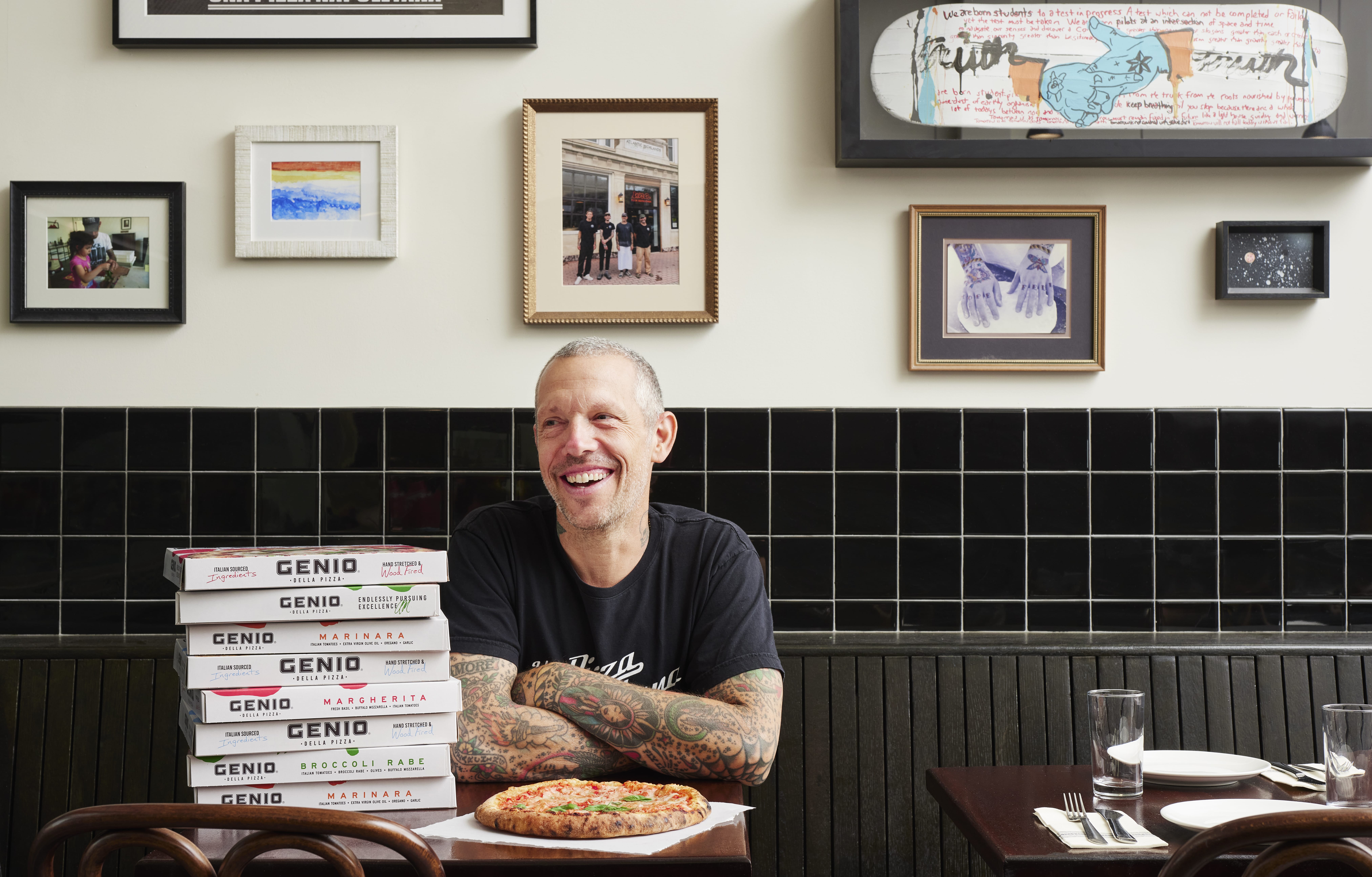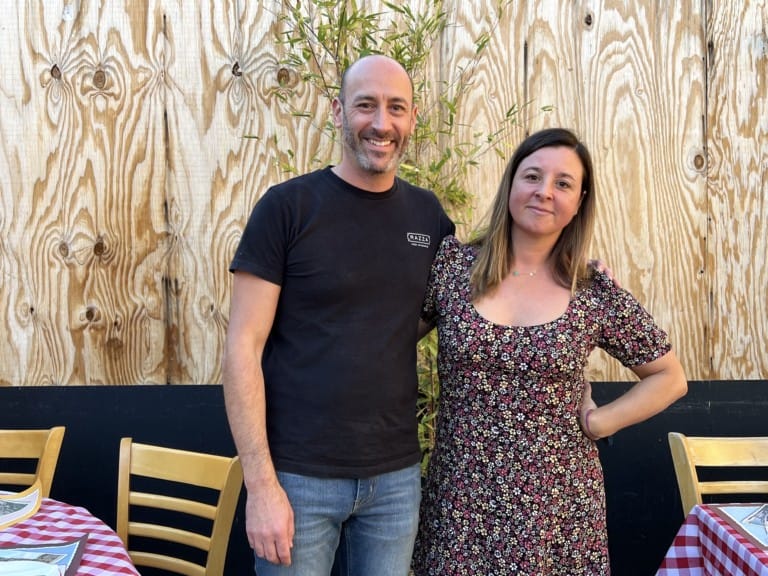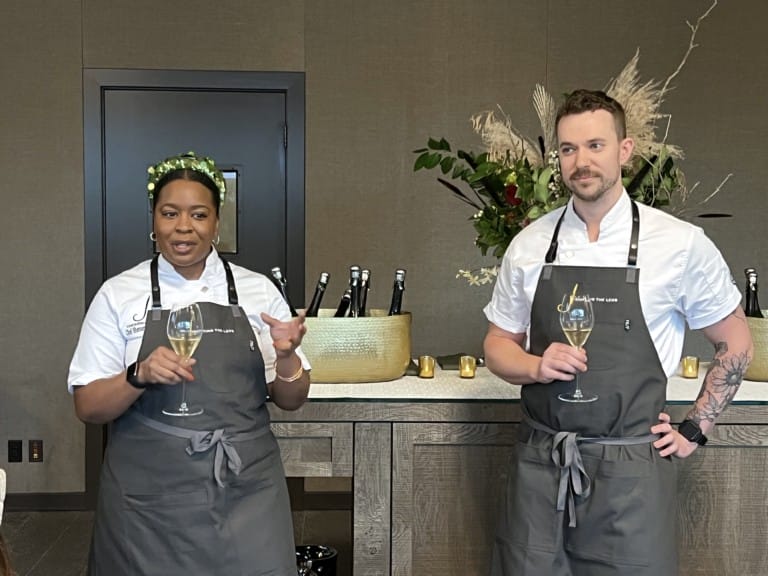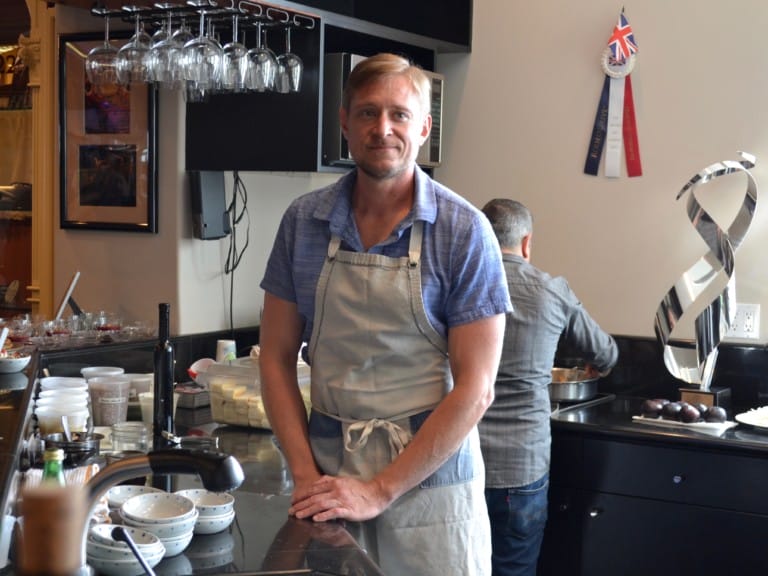INTERVIEW CONTINUED FROM PREVIOUS PAGE
JL: What would you say the key differences are between an Una Pizza pizza and a Genio Della pizza?
AM: Everything. I mean, the only thing that they have in common is the commitment, I think, and the focus on the love and relentlessly trying to make it better. But other than that, that’s where it ends. They’re just two completely different products. I look at Genio, I always tell people, you know, it’s frozen pizza. Let’s just start there. I don’t want to mislead people or try to fake it and be like, “Oh, it’s exactly like in the restaurant.” The restaurant, you know, I make every single dough ball 30 years in, still, every day we’re open. I still make the dough, and if I can’t make the dough, we don’t open. And that’s that. So I’m at the oven every single night we’re open either working the oven or opening pizzas and topping them, so, right there, it’s a completely different product. But that’s also not scalable or something that I can freeze. They’re just totally different. I mean, the only thing that they have in common is me.
JL: Any of the same ingredients?
AM: Some of the flour’s the same. We use the same flour mixtures… We’re a factory setting, we do an analysis, and we lock it in and it’s all set in a computer and made sure that everything makes sense, because you’re just working on much larger scales, and you don’t want to go into the factory run that day and have 30 people working in there, and the expectation that you’re going to produce 25 – 50,000 pizzas, and then figure out that, “Oh, we shouldn’t mess around with the flour percentages.” So there are the same flours, it’s just that in the restaurant, I mess around with them and change them almost daily, ratio wise, not necessarily the grams, but the ratios. Like I’m always tweaking and adjusting, but the factory, in some ways, is a more stable environment than the restaurant because they have the temperature control. They have an incredible proofing room that is just beyond the capacity of a restaurant. So in some ways, they have less risk of things going sideways than I do in a small scale.
JL: Sure. And then, how did you decide which toppings to feature?
AM: Well, I wanted to start out with all the things that were all pretty basic. Then the broccoli one that I did was because when I was able to source friarielli – we say on the box broccoli rabe because no one in America would know what friarielli is – but friarielli is Neapolitan grown broccoli rabe that generally grows only in Campagna around Vesuvius. And it just has a much different hint of a flavor than broccoli rabe. I think it’s more interesting and a little more minerally. So when I was able to get that for this, and discovered that that was an option, that there was someone that could supply that at scale in the way that we needed, I was like, “Oh my god, I gotta do this.” And I wanted something that also a vegetable based pizza. So I thought it was a nice balance. And then the other three are based on what we do in the restaurant for 30 years, the Margherita, Bianca and Marinara. The Marinara is nice because it’s vegan. Even though we’ve never marketed it like that, we probably will change that in the next round of packaging ti say vegan on it, just so people are aware of it because there’s such a big demand for that type of stuff. But what I love about also the Bianca or the Marinara is that they’re great vehicles to fool around with for the home consumers. I look at the Marinara as something that I would bring home and add anchovies after I took it out. And I would grate like a really awesome Pecorino Romano with some olive oil. Then just in a few easy steps, you’re elevating this into a whole nother place that, in my opinion, is equal to going to a nice place to eat if you have a little side salad, and it takes like 10 minutes and you’re eating dinner.
JL: How do you feel about meat on pizza at this point?
AM: No issues. In the pizzeria itself, at Una, we added things to the menu slowly over the last five or six years. So I have a small assortment of things that I add. We have our basic pizzas as always, but then we do a special one every week, which is always something super fun and interesting. Topping wise at the pizzeria, I have anchovies as an option. I go back and forth between Sicily and the Amalfi Coast. I have Calabrian long hot peppers. I have Parmigiano Reggiano, freshly grated when you order the pizza, and I put pepperoni in quotes because it’s not really pepperoni. It’s Italian salami, but we slice it every morning fresh, and you can get that on the four basic pizzas. On a special pizza, we don’t allow any alterations or additions. I loosened up a little bit.
JL: What do you remember about frozen pizzas growing up?
AM: You know, the one that I loved growing up was Ellio’s. That’s what I remember. There were two things that I really loved growing up. One was Ellio’s frozen pizza, and I grew up in a family where my mother and grandmother were obsessed with hot peppers. Like they used them to make every single thing spicy. So at a pretty young age. I can remember eating frozen Ellio’s squares with hot peppers on top of them. I don’t remember if my mom would put them on before or after she would heat the pizza. I remember it sort of being after. Then the other thing that I really, really loved when I was really young, and I haven’t had in probably 40 years, is the pizza rolls. I don’t remember the name of the company. I feel like it’s Totino’s or something. They were these little, tiny, like one inch by two inch little ravioli square things of dough filled with something, god knows what, but I liked those when I was like 10 years old. But when it comes to frozen pizzas, I pretty much stopped eating frozen pizzas or anything of that category at a pretty young age. And I’ve never gone back.
JL: Where are you at in terms of Genio Della Pizza at this point? Are you happy with it or are you still tinkering?
AM: I’m happy with it, but I don’t want to stop there. And I think that’s one of the cool things that I bring to the table in the CPG world. I’m having a learning experience every day of the week, because the food stores are basically run like the mafia. And it’s a heartbreaking world out there. The way they all operate with these slotting fees, promotions, and all the stuff that they force on you when, for a restaurant person, you’re like, “I don’t understand. Why would I give you my product at 50% off when I’m not getting a discount. Like it costs what it costs to make it. It’s food. There’s no discount.” So I’m trying to go at it like that. And people are just like, “You’re out of your mind. That’s not how it works.” So it’s a very tough world out there. And the frozen space is probably one of the toughest of that world because obviously in the food store, the freezer section is limited because it costs a lot of money to run because it’s all electric. And it’s not as easy as just being on a shelf somewhere with a shelf stable item. So it’s been tough, but I think what I bring to the table is the idea of not being set with the product. I want to continue to make it better, and I think that’s not a typical CPG company attitude. Most of these products, like when they launched, it’s like that’s probably the best it’s ever going to be. If it does change most of the time, it gets worse because they keep trying to scale, scale, scale, exit to Campbell’s and see you later which believe me, I would love to exit to Campbell’s and live in Malibu and make pizza one day a week and ride my bike, but until that happens, and as long as I have anything to do with it, the product is going to continue to get better.
JL: In what ways has this process with Genio Della Pizza made you a better pizzaiolo? Has it made you better or impacted what you do at Una Pizza?
AM: I mean, I think it makes me better only because I just keep learning constantly about things and those things on a bigger scale. What it actually does on a day to day at Una, probably, if anything, makes me appreciate that small world that I live in there. I like the contrast and I’m very thankful that I have that right now. I can deal with food stores and I can deal with brokers and all these high level CEO type matters that, you know, were never in my wheelhouse, and then a couple days a week, I kind of drop out. I can’t do that 100% on those days, but more or less, I try to just be like, “Alright, now I’m in Una mode,” and focus on that. And I appreciate that. And I love – I don’t know how to say it – if anything, it just really makes me appreciate what I have there. And the beauty of that.
JL: So you’re happy with the one restaurant at this point? No plans to build another restaurant again?
AM: Never. I mean, if I build another restaurant, then that would be the only restaurant, but I never want to have more than one. And that was also sort of the thinking behind this CPG idea. How can I connect with people on a bigger scale? How can I grow and hopefully financially get to a place to be a little safe for once in my life without altering what I do at the restaurant? It’d be like, open 10 restaurants and cash in on that. And obviously, I’ve opened restaurants multiple times over 30 years. You know, I just can’t do it. Like when I’m in Una, man, that’s like my baby, and I love it. Like to death, and nothing can stand in the way of what that needs to be. And I would rather do something separately given all my love, but know that that is that and this is this and and keep it that way. So if you want to have Una, you can come to Una and I’ll be there.
JL: It sounds like a great dynamic, having both.
AM: Yeah, it is. It’s exciting, you know, and I love to grow, and I love learning, and I love doing something that’s allowing me to grow and continue to just evolve as an adult and a business person. But then still keep Una in its state as it should be and not dilute that. So it’s a really awesome thing. I’m extremely grateful right now that that’s possible. And hopefully it works.









Leave a Comment